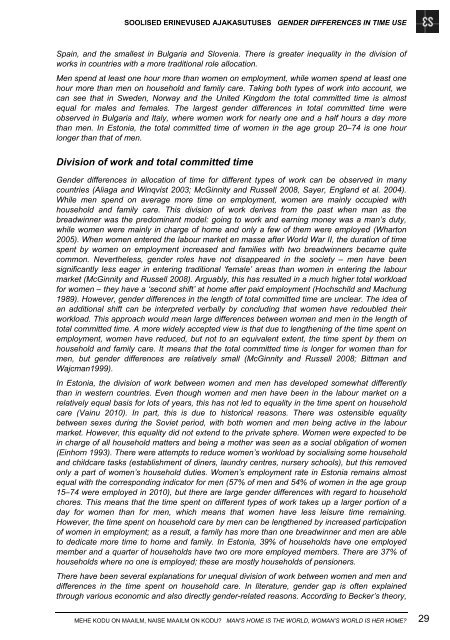MEHE KODU ON MAAILM, NAISE MAAILM ON KODU? - Tartu Ãlikool
MEHE KODU ON MAAILM, NAISE MAAILM ON KODU? - Tartu Ãlikool
MEHE KODU ON MAAILM, NAISE MAAILM ON KODU? - Tartu Ãlikool
You also want an ePaper? Increase the reach of your titles
YUMPU automatically turns print PDFs into web optimized ePapers that Google loves.
SOOLISED ERINEVUSED AJAKASUTUSES GENDER DIFFERENCES IN TIME USE<br />
Spain, and the smallest in Bulgaria and Slovenia. There is greater inequality in the division of<br />
works in countries with a more traditional role allocation.<br />
Men spend at least one hour more than women on employment, while women spend at least one<br />
hour more than men on household and family care. Taking both types of work into account, we<br />
can see that in Sweden, Norway and the United Kingdom the total committed time is almost<br />
equal for males and females. The largest gender differences in total committed time were<br />
observed in Bulgaria and Italy, where women work for nearly one and a half hours a day more<br />
than men. In Estonia, the total committed time of women in the age group 20–74 is one hour<br />
longer than that of men.<br />
Division of work and total committed time<br />
Gender differences in allocation of time for different types of work can be observed in many<br />
countries (Aliaga and Winqvist 2003; McGinnity and Russell 2008, Sayer, England et al. 2004).<br />
While men spend on average more time on employment, women are mainly occupied with<br />
household and family care. This division of work derives from the past when man as the<br />
breadwinner was the predominant model: going to work and earning money was a man’s duty,<br />
while women were mainly in charge of home and only a few of them were employed (Wharton<br />
2005). When women entered the labour market en masse after World War II, the duration of time<br />
spent by women on employment increased and families with two breadwinners became quite<br />
common. Nevertheless, gender roles have not disappeared in the society – men have been<br />
significantly less eager in entering traditional ‘female’ areas than women in entering the labour<br />
market (McGinnity and Russell 2008). Arguably, this has resulted in a much higher total workload<br />
for women – they have a ‘second shift’ at home after paid employment (Hochschild and Machung<br />
1989). However, gender differences in the length of total committed time are unclear. The idea of<br />
an additional shift can be interpreted verbally by concluding that women have redoubled their<br />
workload. This approach would mean large differences between women and men in the length of<br />
total committed time. A more widely accepted view is that due to lengthening of the time spent on<br />
employment, women have reduced, but not to an equivalent extent, the time spent by them on<br />
household and family care. It means that the total committed time is longer for women than for<br />
men, but gender differences are relatively small (McGinnity and Russell 2008; Bittman and<br />
Wajcman1999).<br />
In Estonia, the division of work between women and men has developed somewhat differently<br />
than in western countries. Even though women and men have been in the labour market on a<br />
relatively equal basis for lots of years, this has not led to equality in the time spent on household<br />
care (Vainu 2010). In part, this is due to historical reasons. There was ostensible equality<br />
between sexes during the Soviet period, with both women and men being active in the labour<br />
market. However, this equality did not extend to the private sphere. Women were expected to be<br />
in charge of all household matters and being a mother was seen as a social obligation of women<br />
(Einhorn 1993). There were attempts to reduce women’s workload by socialising some household<br />
and childcare tasks (establishment of diners, laundry centres, nursery schools), but this removed<br />
only a part of women’s household duties. Women’s employment rate in Estonia remains almost<br />
equal with the corresponding indicator for men (57% of men and 54% of women in the age group<br />
15–74 were employed in 2010), but there are large gender differences with regard to household<br />
chores. This means that the time spent on different types of work takes up a larger portion of a<br />
day for women than for men, which means that women have less leisure time remaining.<br />
However, the time spent on household care by men can be lengthened by increased participation<br />
of women in employment; as a result, a family has more than one breadwinner and men are able<br />
to dedicate more time to home and family. In Estonia, 39% of households have one employed<br />
member and a quarter of households have two ore more employed members. There are 37% of<br />
households where no one is employed; these are mostly households of pensioners.<br />
There have been several explanations for unequal division of work between women and men and<br />
differences in the time spent on household care. In literature, gender gap is often explained<br />
through various economic and also directly gender-related reasons. According to Becker’s theory,<br />
<strong>MEHE</strong> <strong>KODU</strong> <strong>ON</strong> <strong>MAAILM</strong>, <strong>NAISE</strong> <strong>MAAILM</strong> <strong>ON</strong> <strong>KODU</strong>? MAN’S HOME IS THE WORLD, WOMAN’S WORLD IS HER HOME? 29

















